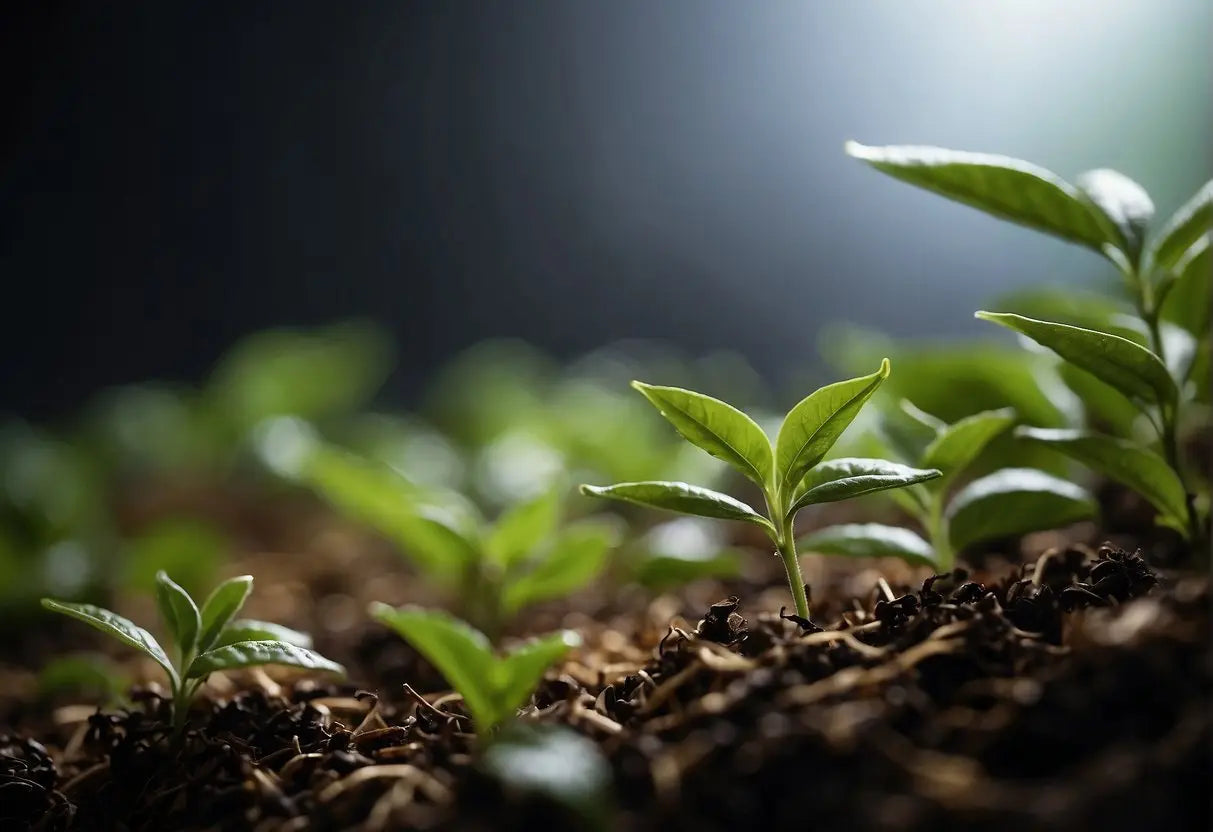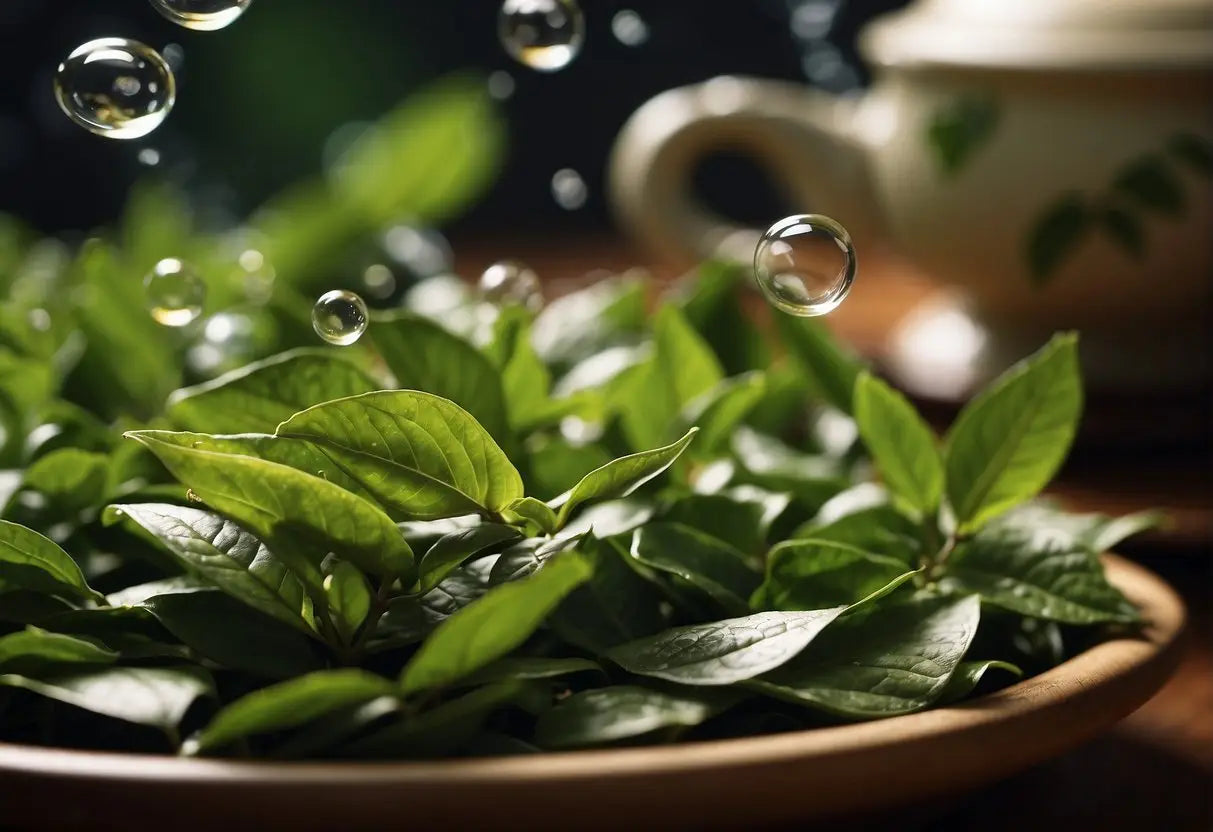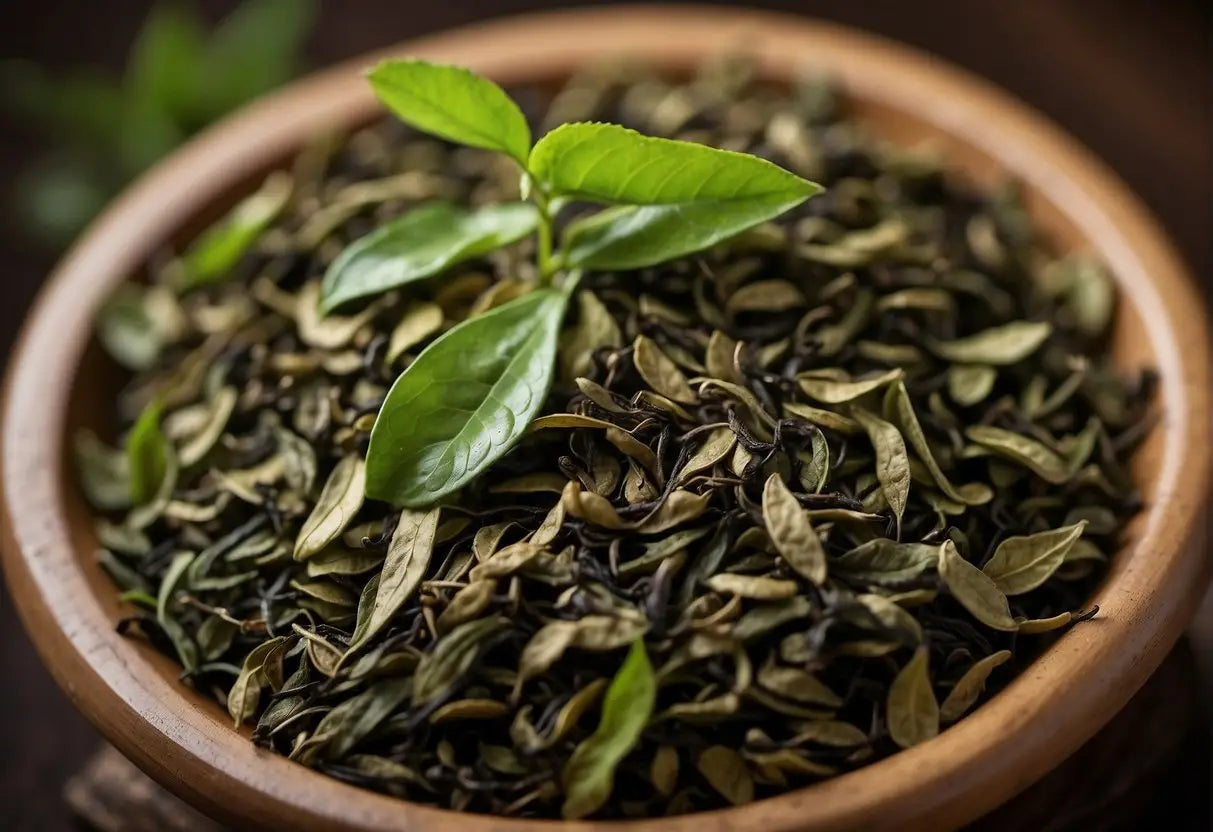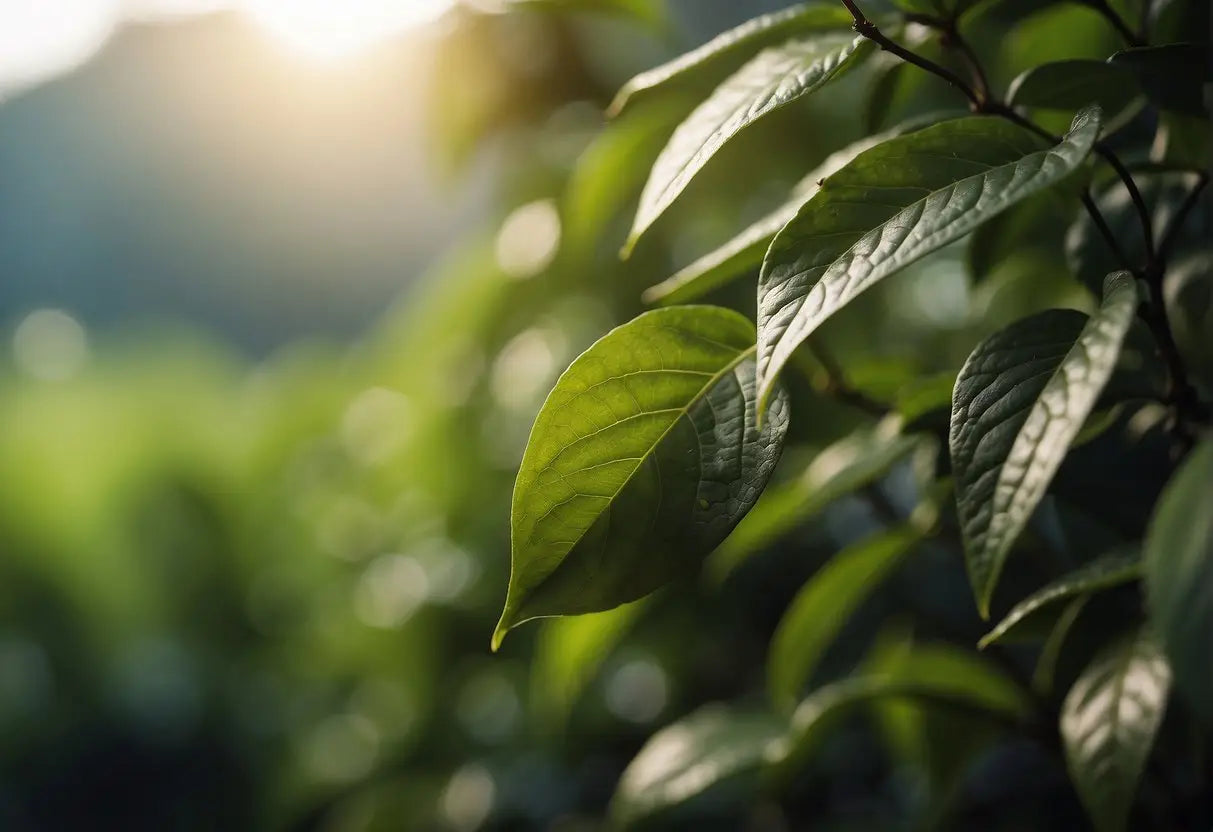How is Tea Fermented
In tea production, fermentation refers to the oxidation process of tea leaves which influences flavor, color, and aroma.
Definition of Tea Fermentation
Tea fermentation is not fermentation in the traditional biological sense where microorganisms such as yeast and bacteria induce changes. It's actually an oxidative process that begins as soon as the tea leaves are plucked and enzymes within the leaf cells are exposed to air.

Bestsellers
Types of Tea Fermentation
Tea can undergo various levels of fermentation, each producing different types of tea:
- Green Tea: Minimal oxidation, where leaves are heated shortly after harvest to deactivate enzymes.
- White Tea: Very lightly oxidized; retains a delicate flavor and natural aroma.
- Oolong Tea: Partially oxidized, striking a balance in the complexity of flavor between green and black teas.
- Black Tea: Fully oxidized, offering a robust flavor and the darkest color.
- Pu-erh Tea: A post-fermented tea where oxidation continues even after processing through microbial fermentation.
Chemical Changes During Fermentation
During fermentation, the tea leaves undergo significant chemical transformations:
- Polyphenols oxidize and form new compounds like theaflavins and thearubigins, which contribute to the taste and color of the tea.
- Chlorophylls break down, which changes the leaf color from green to brown.
- The breakdown of proteins and amino acids leads to the development of new flavors and aromas.
Fermentation Process

The fermentation process is central to transforming fresh tea leaves into the diverse range of flavors found in finished tea products.
Harvesting and Withering
Once you harvest the fresh tea leaves, they need to undergo withering. This step involves evenly spreading the leaves in a thin layer and exposing them to carefully controlled warm air. It’s essential to reduce the moisture content of the leaves to about 50-70%, which prepares them for the next stage of fermentation.
Rolling and Bruising
The withered leaves are then rolled, either by hand or using machinery. This process breaks down the cell walls, consequently causing the essential oils and sap to ooze from the leaves, which is crucial for developing the tea's flavor profile.
- Objective: Release enzymes and essential oils
-
Method:
- Manual: Gently twist and roll the leaves
- Machine-assisted: Press and twist the leaves using mechanical rollers
Oxidation
Subsequently, the bruised leaves are spread out to undergo oxidation, also commonly referred to as fermentation. During this phase, the oxygen in the air interacts with the enzymes released during the rolling process.
- Enzymatic Oxidation: The cellular compounds react with oxygen, leading to browning.
-
Chemical Changes:
- Flavanols to Theaflavins: Bright and brisk flavors
- Theaflavins to Thearubigins: Rich and robust flavors
-
Duration:
- Black Tea: Full oxidation (several hours)
- Oolong Tea: Partial oxidation (1-5 hours)
Halting Fermentation
Finally, you must stop the oxidation at the desired level to lock in the tea’s flavor and prevent spoilage.
- Heat Application: Exposing the leaves to high temperatures deactivates the enzymes.
-
Methods:
- Pan-firing: Direct heat in pans for teas like Chinese green tea
- Steaming: For Japanese green teas, halting oxidation within minutes
- Baking/Drying: In ovens for black teas, where extended drying sets the final moisture content to below 5%.
Factors Influencing Fermentation

Fermentation is a critical process in tea production that affects the flavor, color, and aroma of the final product. Understanding the key factors that influence fermentation will help you master the tea-making process.
Temperature Control
You need to maintain a specific temperature range to optimize the fermentation process. Generally, a temperature between 20-30°C (68-86°F) is ideal. This range encourages the enzymatic activity necessary for fermentation. If the temperature is too low, the process will slow down, while excessively high temperatures can kill the beneficial enzymes.
Humidity Levels
The humidity level during fermentation plays a significant role in the quality of the tea. Aim for a relative humidity of around 75-80%. Higher humidity can lead to mold growth, whereas lower humidity may dry out the leaves too quickly, halting the fermentation.
Lao Ban Zhang
Duration
The length of fermentation varies depending on the type of tea being produced. For example:
- Black tea: typically 3 to 5 hours
- Oolong tea: can range from 2 to more than 20 hours
Monitoring the change in leaf color and aroma can help you determine the appropriate time to halt fermentation.
Tea Leaf Variety
Different tea leaves react uniquely to the fermentation process. The variety of the tea plant (Camellia sinensis) will influence the enzyme content and thus the fermentation rate and flavor profile. For example, Assamica leaves ferment quicker than Sinensis leaves, resulting in bolder flavors.
Types of Fermented Teas
In your exploration of fermented teas, it’s important to distinguish between the various types, each with their unique processing methods and flavor profiles.
Black Tea
Your typical black tea undergoes full oxidation. Leaves are first withered to reduce moisture, then rolled to break cell walls, initiating oxidation. Oxidation imparts a rich flavor and dark color before the leaves are dried to halt the process.
Oolong Tea
Oolong tea represents a category between black and green teas, with partial oxidation. This results in a spectrum of flavors ranging from floral to toasty. The degree of oxidation can vary widely, typically between 10%-70%, affecting the final taste profoundly.
Pu-Erh Tea
Pu-erh tea is a type of fermented tea that comes in raw (Sheng) or ripened (Shou) forms. It undergoes a unique post-fermentation process where microbial fermentation occurs after the leaves are dried and rolled. This tea is often aged, developing a complex flavor over time.
Health Benefits and Myths

When you drink fermented tea, such as kombucha or traditional fermented black or green teas, you might be aware of various health claims surrounding these drinks. It's important to distinguish between what is supported by scientific evidence and what is myth.
Health Benefits:
- Probiotics: Fermented tea can contain probiotics, which can improve your gut health.
- Antioxidants: You'll find antioxidants in fermented teas, which may reduce cellular damage caused by free radicals.
- Polyphenols: These compounds may contribute to reducing inflammation and combating chronic diseases.
Table: Supported Health Benefits of Fermented Tea
| Benefit | Explanation |
|---|---|
| Enhances Digestive Health | May increase beneficial gut bacteria. |
| Offers Antioxidant Properties | Helps in protecting cells from oxidative stress. |
| Aids in Reducing Inflammation | Polyphenols play a role in inflammation reduction. |
Health Myths:
- Cure-All: Despite claims, fermented tea isn't a cure for all ailments.
- Detoxification: The body naturally detoxifies; tea can't accelerate this process significantly.
- Weight Loss: While some believe it can aid weight loss, evidence is limited and indirect.
List: Common Myths about Fermented Tea
- Myth: It can replace medications
- Myth: It detoxifies the body magically
- Myth: It leads to significant weight loss effortlessly
When you're incorporating fermented teas into your diet, it's good to remember that while they can contribute to a healthy lifestyle, they should not be seen as magic potions but as part of a balanced diet and proper healthcare routine. Always be wary of unsubstantiated health claims, and when in doubt, consult health professionals for advice tailored to your personal health needs.
Fermentation Equipment and Space
When preparing your tea for fermentation, the right equipment is essential to ensure a controlled process. You'll need:
- Fermentation vessels: Choose materials like glass, ceramic, or food-grade plastic. Metal is generally avoided as it can react with tea and affect the flavor.
- Temperature control: Fermentation requires consistent, warm temperatures, often between 75°F and 85°F. Consider a temperature-controlled space or a heating mat.
- Cloths and Covers: Breathable cloths like cotton or linen will cover your fermentation vessels, keeping contaminants out while allowing air to circulate.
- Measuring Tools: Hydrometers and pH meters help monitor the tea's fermenting progress.
- Sanitization supplies: Always have food-safe sanitizers on hand to keep your equipment clean and your tea free from unwanted bacteria.
Your fermentation space should be:
- Clean and Sanitary: A dust-free and well-sanitized area prevents contamination.
- Temperature Controlled: Either naturally warm or capable of maintaining the necessary temperature range through artificial means.
- Away from Direct Sunlight: Ultraviolet rays can hinder the fermentation process.
- Quiet and Undisturbed: Constant movement or vibrations can disrupt the fermentation process.
The layout of your space matters. Organize your equipment for ease of use, leaving ample room to work comfortably. Remember, consistency is key in fermentation – both in the equipment you use and the environment you maintain.
Quality Control Measures
When fermenting tea, it's essential to implement stringent quality control measures to ensure the final product meets the desired standards of flavor, aroma, and safety. Here are some key steps in the process:
-
Ingredient Inspection: Ensure all raw materials, such as tea leaves and additional flavorings, are of high quality. Look for any signs of deterioration or contamination.
-
Monitoring Fermentation Conditions: Maintain precise control over the temperature, humidity, and cleanliness of the fermentation environment.
-
Sanitation Protocols: Regularly sanitize equipment and workspaces to prevent the introduction of unwanted microorganisms. Use a checklist to verify that proper cleaning procedures are followed.
-
Tasting and Aroma Checks: Periodically sample the tea during fermentation to assess its flavor and aroma profile, making sure they align with product specifications.
-
Microbial Testing: Conduct lab tests to detect potential pathogens or spoilage organisms. Aim for a zero-tolerance policy regarding harmful bacteria.
-
Record Keeping: Keep detailed records of all batches, including ingredients used, fermentation conditions, and test results. This helps trace any issues back to their source.
By adhering to these quality control measures, you can help guarantee that the fermented tea you produce is consistently safe, delicious, and of the highest quality.
Frequently Asked Questions

In this section, you'll find precise answers to common queries about tea fermentation, from the semantics of processing terminology to the specific variations of tea involved and the impacts on health and production.
What is the difference between fermentation and oxidation in tea processing?
Fermentation in tea is often confused with oxidation, but they are not the same. During tea processing, oxidation is a chemical reaction involving oxygen and the tea leaves' enzymes, while fermentation is a microbial process that can occur in the presence or absence of oxygen, often giving rise to complex flavors.
Which varieties of tea are considered fully fermented?
Pu-erh and black teas are considered fully fermented. A complete fermentation process gives these teas their characteristic dark color and rich, bold flavors.
What are the health benefits associated with drinking fermented black tea?
Fermented black tea is linked to several health benefits, including antioxidant properties, potential reductions in cholesterol levels, and support for cardiovascular health. Regular consumption can also improve gut health due to the microbial activity in the fermentation process.
How can tea fermentation lead to the production of alcoholic beverages?
Through extended fermentation under specific conditions, tea can be combined with yeast and sugar to produce kombucha, a slightly alcoholic beverage. The process involves a symbiotic culture of bacteria and yeast (SCOBY) that ferments the sweetened tea over time.
What are the key stages of the tea fermentation process?
The key stages of tea fermentation include withering (reducing moisture content of the leaves), rolling (breaking down the leaf cells to release enzymes), oxidizing (allowing enzymatic reactions to darken the leaves), and firing (halting oxidation and drying the leaves).
Can you list teas that undergo no fermentation at all?
Green teas and white teas undergo no fermentation. These teas are rapidly heated after harvesting to inactivate enzymes, thus preventing oxidation and fermentation and preserving a light color and delicate flavor profile.
← Older post Newer post →











